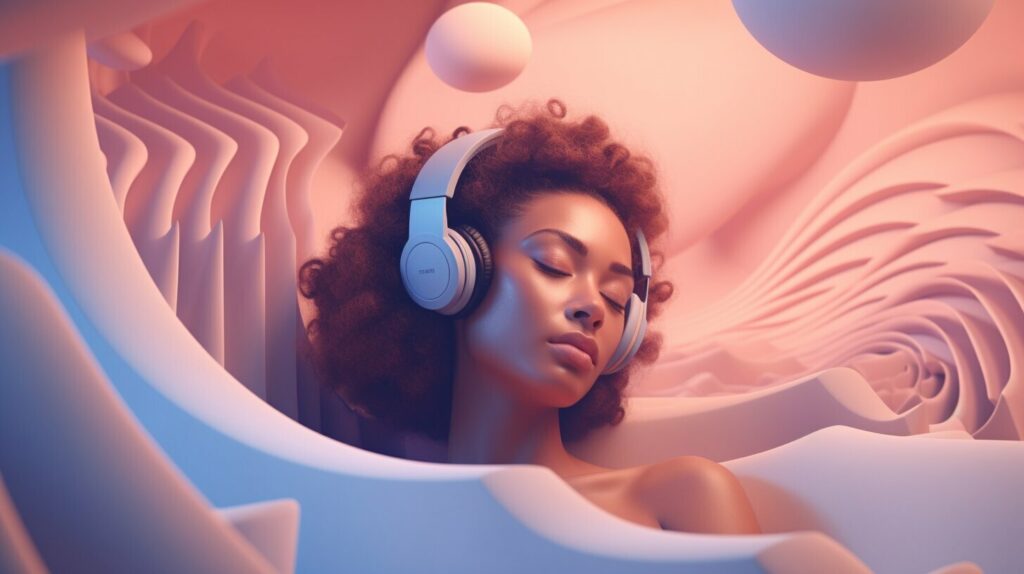Hello there! Have you ever heard of lucid dream music? If you’re someone who is interested in exploring the depths of your subconscious mind, you may have come across this term before. Lucid dream music is a form of audio that is specifically designed to enhance dreaming experiences, especially lucid dreaming.
But the question remains: does lucid dream music actually work? In this article, we’ll explore the effectiveness of lucid dream music and how it can help you to achieve more vivid and profound dream states.
Key Takeaways:
- Lucid dream music is specifically designed to enhance dream experiences, especially lucid dreaming.
- We’ll explore the effectiveness of lucid dream music and how it can help you to achieve more vivid and profound dream states.
Understanding Lucid Dreaming
Before we dive into the effectiveness of lucid dream music, let me provide a brief overview of what lucid dreaming is and how it works. Essentially, lucid dreaming is the act of becoming aware that you are dreaming while you are still in the dream state.
This realization opens up a world of possibilities, as you can manipulate and control aspects of the dream, essentially becoming the director of your own subconscious movie. This can lead to incredibly vivid and memorable dream experiences, as well as opportunities for personal development and exploration.
Lucid dreaming can occur naturally, but it can also be achieved through various techniques and practices. Some common methods include reality checking, in which you perform small tests to determine whether you are dreaming or awake, and visualization exercises to enhance dream clarity.
It is important to note that while lucid dreaming can be a thrilling and enlightening experience, it is not for everyone. Some individuals may find it difficult to achieve or may experience negative side effects such as sleep disruption or confusion. It is always important to practice lucid dreaming safely and with caution.

The Power of Sound in Dreams
Our subconscious mind is strongly influenced by sound, both in our waking state and during sleep. It is through sound that we can access deeper levels of consciousness, and it can even influence the way we dream. That’s where lucid dream music comes in.
Lucid dream music is specifically designed to stimulate the brain with sounds that promote lucid dreaming. The music incorporates binaural beats or isochronic tones, which are two different types of sound frequencies that are believed to put the brain in a state of relaxation and heightened awareness.
One of the main benefits of lucid dream music is that it can help to block out external distractions and induce a meditative state. When we listen to calming music, our heart rate and breathing slow down, and our brain waves start to match the rhythm of the music. This allows us to enter a more relaxed state, making it easier to fall asleep and stay asleep throughout the night.
Beyond promoting relaxation, lucid dream music can also enhance the dream experience itself. The sounds in the music can affect the content of our dreams, making them more vivid and memorable. This, in turn, can make it easier to recognize when we are dreaming, leading to more frequent and meaningful lucid dreams.

The image above shows a visualization of isochronic tones, one of the sounds used in lucid dream music. As you can see, the tone consists of a pulse-like pattern. It is believed that this type of sound can help synchronize the two sides of the brain, which may be helpful in promoting lucid dreaming.
Overall, the power of sound in dreams cannot be overstated. By using specifically designed lucid dream music, we can harness this power to enhance our dream experiences and ultimately achieve more frequent and vivid lucid dreams.
How Does Lucid Dream Music Help?
Lucid dream music works by incorporating specific frequencies, rhythms, and melodies that stimulate the brain in ways that promote lucid dreaming. These sounds are designed to alter brainwave patterns, inducing a state of relaxation and increasing the likelihood of entering a lucid dream state.
The brainwave patterns affected by lucid dream music are delta, theta, and gamma waves. Delta waves occur during deep sleep, while theta waves are present during the dream state. Gamma waves are associated with higher cognitive functioning and may play a role in enhancing consciousness during lucid dreaming.
Lucid dream music also utilizes binaural beats, which are two different tones played in each ear to create the perception of a single tone. These beats are believed to synchronize brainwave patterns, leading to a more focused and relaxed state conducive to lucid dreaming.
Overall, lucid dream music helps by creating a relaxing and supportive environment for the brain to enter a lucid dream state. However, it is important to note that lucid dreaming is a highly individual experience and may not work for everyone. Nevertheless, it is worth experimenting with various forms of lucid dream music to see what works best for you.

Image description: An image of a person sleeping with headphones on, symbolizing the use of lucid dream music to enhance dreams.
Benefits of Lucid Dream Music
Lucid dream music offers a range of potential benefits beyond simply enhancing lucid dreaming. Research suggests that listening to music before bed can promote relaxation and better sleep. This can lead to more restful and restorative sleep, which in turn can increase feelings of well-being and reduce stress levels.
Additionally, lucid dream music can stimulate creativity and self-awareness. By immersing oneself in the dream world, individuals may be able to tap into their subconscious minds and access new insights and ideas. This can be particularly beneficial for artists, writers, and other creatives who are looking for inspiration.
Another potential benefit of lucid dream music is its ability to aid in overcoming nightmares. For individuals who suffer from recurring nightmares, listening to calming music before bed can help to soothe the mind and promote more positive dreaming experiences.

Finally, lucid dream music can be a fun and exciting way to explore the dream world and our own internal landscapes. By experimenting with different types of music and lucid dreaming techniques, individuals may be able to experience new levels of self-discovery and personal growth.
Lucid Dreaming Techniques and Meditation
Lucid dream music can be a powerful tool to aid in inducing lucid dreams, but it can also be incorporated with various techniques and meditation practices to enhance its effectiveness. Below are some techniques that I have found useful:
- Reality checks: Throughout the day, ask yourself, “Am I dreaming?” and perform a reality check. This can be anything from looking at a clock and then looking away, and then looking back to see if the time has changed, to pinching your nose and trying to breathe through it. This practice can carry over into your dreams, allowing you to recognize when you are dreaming.
- Visualization: Before going to bed, visualize yourself becoming lucid in a dream. Imagine the vivid details of the dream and how you will feel once you become lucid. This can help to set the intention in your mind and increase the likelihood of a lucid dream.
- Wake-back-to-bed: Set an alarm for 4-6 hours after you go to bed. When the alarm goes off, wake up and stay awake for 15-20 minutes. During this time, read about lucid dreaming or practice a relaxation technique like meditation. Then go back to sleep with the intention of having a lucid dream.
When incorporating lucid dream music into your practice, it’s important to find a technique that works best for you. I have found that combining lucid dream music with meditation can be particularly effective. By focusing on the music and allowing your mind to relax, you can enter a state of lucidity and increase the likelihood of a lucid dream.
Lucid Dreaming Techniques and Meditation Example
One meditation technique that I have found helpful is the body scan meditation. To begin, find a comfortable position and close your eyes. Focus on your breath and begin to scan your body from head to toe. Pay attention to any areas of tension or discomfort and focus on releasing them. As you move through your body, imagine yourself becoming more and more relaxed. You can incorporate lucid dream music into this practice by playing it softly in the background.
Remember, lucid dreaming is a skill that takes practice and patience. By incorporating lucid dream music with various techniques and meditation practices, you can increase your chances of having a lucid dream and enhance your overall dream experience.

Exploring Brainwave Entrainment
Brainwave entrainment is a technique used in lucid dream music that involves syncing the brain’s electrical activity with external stimuli, such as sound or light. This synchronization is achieved through the use of specific frequencies and rhythms, which can alter the brainwaves and ultimately influence the state of consciousness.
The theory behind brainwave entrainment is that by exposing the brain to certain frequencies, it can be induced to enter specific states, such as relaxation, meditation, or lucid dreaming. In the case of lucid dream music, brainwave entrainment is often used to promote alpha and theta brainwave activity, which are associated with deep relaxation and heightened creativity.
One common form of brainwave entrainment used in lucid dream music is binaural beats. This involves playing two different frequencies in each ear, which the brain then perceives as a single tone with a frequency equal to the difference between the two. For example, playing a 200 Hz frequency in one ear and a 210 Hz frequency in the other ear can create a perceived tone with a frequency of 10 Hz, which is associated with increased relaxation and meditation.
| Beta | 13-30 Hz | Active, alert |
|---|---|---|
| Alpha | 8-12 Hz | Relaxed, meditative |
| Theta | 4-7 Hz | Deep relaxation, dreaming |
| Delta | 1-3 Hz | Deep sleep |
Another form of brainwave entrainment is isochronic tones, which involve rapidly pulsing a tone on and off to create a perceived frequency that matches the desired brainwave state. These tones are often used in conjunction with binaural beats for increased effectiveness.
While there is some debate over the effectiveness of brainwave entrainment, many individuals report success in inducing lucid dreams through the use of lucid dream music that incorporates these techniques.

Sleep Music for Lucid Dreaming
If you’re looking to enhance your chances of lucid dreaming, there are a variety of sleep music options available that can aid in inducing these types of dreams. Unlike specific lucid dream music, which is designed to stimulate the brain in specific ways, sleep music for lucid dreaming is generally more calming and relaxing, creating a peaceful environment for the mind to wander.
Many people find that listening to calming sleep music before bed can help relax their mind and body, making it easier to fall asleep and enter into a state where lucid dreaming is more likely to occur. This can be especially effective when combined with other lucid dreaming techniques, such as reality checks and mnemonic induction.
When choosing sleep music for lucid dreaming, it’s important to find something that resonates with you personally. Some people find that nature sounds or gentle instrumental music work best, while others may prefer white noise or ambient sounds. Experimentation is key, and you may find that different types of sleep music work better for you on different nights.
Whatever type of sleep music you choose, be sure to listen to it at a low volume and in a comfortable position. Avoid anything too stimulating or distracting, as this can make it harder to fall asleep. With the right sleep music and lucid dreaming techniques in place, you may be surprised at the results you’re able to achieve.

Conclusion
After diving into the world of lucid dream music, I can confidently say that it has the potential to enhance dream experiences. While it may not work for everyone, many individuals have reported positive effects from using this form of music.
It’s important to keep in mind that lucid dreaming is a skill that takes practice and patience. Adding lucid dream music to your practice can be a powerful tool to aid in inducing lucid dreams and enhancing dream experiences.
Remember, there are various techniques and meditation practices that can be paired with lucid dream music to create a more effective experience. Exploring different forms of lucid dream music and finding what works best for you can lead to exciting results.
Overall, I believe that lucid dream music is worth trying for anyone interested in exploring the world of lucid dreaming. Happy dreaming!
FAQ
Q: Does Lucid Dream Music Work? Exploring its Effectiveness.
A: In this section, we will delve into the effectiveness of lucid dream music and its impact on enhancing dreams.
Q: Understanding Lucid Dreaming
A: Before exploring the effectiveness of lucid dream music, it’s important to have a basic understanding of what lucid dreaming is and how it works.
Q: The Power of Sound in Dreams
A: Sound has a profound impact on our subconscious mind, and this extends to the dream world as well. Lucid dream music aims to harness this power to enhance our dream experience.
Q: How Does Lucid Dream Music Help?
A: Lucid dream music incorporates specific frequencies, rhythms, and melodies that are believed to stimulate the brain in ways that promote lucid dreaming. Let’s explore the mechanisms behind this phenomenon.
Q: Benefits of Lucid Dream Music
A: Lucid dream music offers a range of potential benefits beyond simply enhancing lucid dreaming. From promoting relaxation and better sleep to increasing creativity and self-awareness, let’s take a closer look at these advantages.
Q: Lucid Dreaming Techniques and Meditation
A: Lucid dream music can be used in conjunction with various techniques and meditation practices to aid in inducing lucid dreams. Discover some effective methods for incorporating lucid dream music into your practice.
Q: Exploring Brainwave Entrainment
A: One technique often used in lucid dream music is brainwave entrainment. Learn how this method works and how it can enhance the effectiveness of lucid dream music.
Q: Sleep Music for Lucid Dreaming
A: Apart from specific lucid dream music, there are also general sleep music options available that can aid in inducing lucid dreams. Find out more about the intersection between sleep music and lucid dreaming.
Q: Conclusion
A: After exploring the effectiveness of lucid dream music, it becomes clear that while it may not guarantee lucid dreaming for everyone, it can be a powerful tool in enhancing dream experiences for many individuals. Experimenting with different forms of lucid dream music and combining it with lucid dreaming techniques can lead to exciting results.






